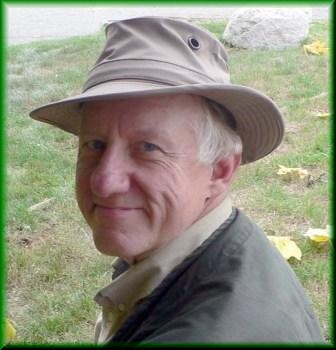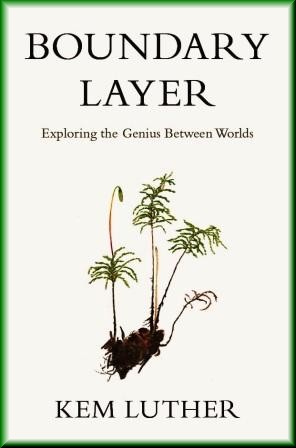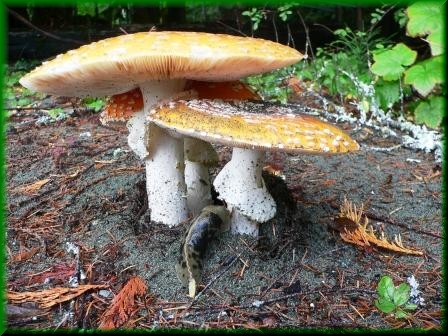Boundary Layer highlights the lives and work of a number of Pacific Northwest naturalists.
In the time between writing and reading that is an inevitable part of the
book publishing industry, these people have moved on with their lives. Interested in what has
happened to these book characters in recent years? I asked the people featured in the book if they
could supply an update to what has happened to them since they provided the initial interviews. Here
is what they had to say.
Andrea Pickart, when I
interviewed her in 2011, had been focusing on issues
relating to shoreline restoration. Over the last few
years, her work at Humboldt Bay National Wildlife
Refuge has shifted a bit. She now does more work on
climate change and sea level rise. In a recently
completed study, Cascadia Geosciences identified the
coastline near Lanphere Dunes as having one of the
highest rates of sea level rise in California, due
largely to local interseismic subsidence. In the
Crescent City area up the coast from Lanphere Dunes,
in contrast, sea levels are barely rising because of local uplifting.
The Refuge has started up research to track sediment transport and accumulation from the nearshore up, over, and behind the foredune.
They are also testing some adaptation measures that use vegetation type to increase resiliency.
To complicate issues, the significant 2016 El Nino brought some very high tide/storm swells
and dramatic erosion. The Refuge
will be tracking the recovery of the beach and dunes over the next few years.
Hans Roemer, though formally retired at the time I interviewed him, was working almost full-time on a series
of contracts to do plant inventories and assessments. He writes in March of 2016: "It is the first time this
year that I have no promise or assurance for contract work, at least at the modest scale it may have been in recent years.
I am 78 and not particularly looking for paid work either. Much of what has occupied me otherwise was increasingly
done as volunteer anyway." Hans, who has an unparalleled knowledge of the vascular flora -- "mountains and alpine flora," he
says, is still his "first and oldest love"--has found his interest turning toward the stegnon that is
the subject of Boundary Layer. He finds, he writes, that he "can now afford to pay more attention
now to other groups, including lichens, bryophytes and fungi. The more you learn, the more fascinating
it gets. I’ve even dabbled in insects, in particular bees and butterflies. Some of these fields of natural history
would not be there to this extent without my wonderful friends who are experts in one or the other of them."
Carl Sieber still works for Pacific Rim National Park, still walks with visitors and talks with
them about the local beach and forest ecosystems. The Wickanninish sand dunes, he says, have altered since since
I interviewed him for the book. Carl writes: "Change is the norm for healthy dune ecosystems and a most
unexpected change happened after your last visit.
Ecosystem restoration efforts had to be co-ordinated with other equally complex efforts. In February, 2012, an unexploded
mortar shell was found and the task fell to the Department of National Defence to clean up the site."
The shell was
exploded at the site two years later. "The
search for more explosives on the dunes--an area
about the size of twenty soccer pitches--was
complicated by ongoing efforts to restore the delicate local environment. Now the military clean-up is done and
great swaths of the invasive grasses have also removed. The dunes are open to the public and more open to
the wind than they have been in a long time. As i write this, it is a very windy day of March 2016. I know for
certain that right now waves of sand are slowly moving and dramatically changing that piece of the park that
is not forest, not beach, but a strange and wonderful child of both."
Danielle Bellefleur is no longer with Parks Canada. When she found out, soon after I
interviewed her, that the dune project would be put on hold and the funding cut by over 80% due to
conflicting government priorities, she took an ssignment as the Monitoring Ecologist at Gulf Islands
National Park Reserve. She was only in the new assignment for a week before that position was cut, though
she was able to spend the rest of the summer in the position before it was finally terminated.
She decided to leave Parks Canada at that point. Danielle writes: "It was a hard, difficult decision,
but I recognized that the current government (Stephen Harper was in power) and CEO of Parks Canada did not have the same
“ecology first" vision of our National Parks system (and thus, were not really following the National
Parks Act). I chose to take care of my 3-year old child, help my husband with his
company, and start a permaculture-designed Certified Organic Orchard called Fruit Forest in Cobble
Hill. I miss the incredible team Parks Canada has, but I really enjoy grafting fruit trees and
watching our orchard take shape. In two years we have grafted and planted over 300 fruit trees,
raised over 400 chickens, received Certified Organic status, and built a passive solar house. Instead
of modelling dune communities, I model orchard communities. I am still fascinated by the natural world,
but spend much of my time trying to understand how our farm ecosystem works, and trying to improve it."
Darren and Claudia Copley continue their work with BC environmental issues. Claudia
is still Senior Collections Manager in Entomology at the Royal BC Museum. She has handed over the editorship
of the Victoria Natural History Society magazine. Darren has become an expert in spider identification and
he and Claudia have been working hard to document the diversity of British Columbia spiders. Finding spiders,
says Claudia involves "a lot of stegnon manipulation: rock flipping, log rolling, stump inspecting." They use
Berlese extractors to sift spiders from soils, leaf litter, and mosses. The effort "takes us into our own
backyard and to places only accessible by helicopter (literally). It has been wonderful to so thoroughly
explore the province we have both lived in all our lives. But, whenever I look at a map, I realize how
little of it we have actually met."
Andy MacKinnon. My 2012 interviews with Andy for Boundary Layer caught him in the
middle of a number of life changes. For the next three years following the interviews, he continued with
his efforts to map and classify ecosystems and to do research in forest ecology, working intensely on
his Haida Gwaii project. To wrap up this 30-year long project, Andy published a field guide to the
Haida Gwaii ecosystems (2014). In the meantime, Simon Fraser University gave him an honorary doctorate
and he published, along with his writing buddy Jim Pojar, the field guide
Alpine Plants of the Northwest.
In 2014 Andy became a member of the vascular plants
section of COSEWIC and was elected Councillor of the
District of Metchosin. He retired from his long
career in the Ministry of Forests, Lands and Natural
Resources in 2015. By the time he left the Ministry,
the Research Branch, which had provided leadership
for the ecologists that were assigned to the eight
regions of the Ministry, had been disbanded.
Currently the Ministry has seven ecologists left—two in
Smithers, one in Prince George, one in Nelson, one in Kamloops,
and two in Nanaimo. Andy’s position disappeared when he retired.
Trevor Goward writes: “My academic
pursuits got knocked out of orbit a few years ago when
Canadian Forest Products announced its plans to log my
home valley near Wells Gray Park. Quite reluctantly, I
found myself forced back into public life as a
grassroots defender of wilderness values, endangered
species, and citizens’ rights. Strictly
speaking, none of this should have been necessary:
first because my community long ago entered into local
land use agreement with the B.C. government which
forbids industrial scale logging here; and second
because Don Kayne, Canfor’s CEO has publicly stated
that his company will not “support actions that impact
parks, riparian areas or areas that provide critical
habitat for species at risk” – though this is
precisely what Canfor is poised to do to Wells Gray’s
fast-dwindling Mountain Caribou herds. The upshot is
that I’m once again living the life of the
environmentalist despite my best intentions. With the
help of some very talented friends, I’ve lately
mounted a save-the-caribou campaign (http://www.wellsgrayworldheritage.ca/),
organized several different public focus events (http://www.speaktothewild.org/),
created two popular treasure hunts (http://www.waysofenlichenment.net/wells/hunt/),
and written a guidebook for kids (Treasure Wells
Gray). Just now I’m editing a major book intended
to help the next generation come to terms with the
mess we’ve left behind.” Trevor lists his goals for
the next year as finishing a couple of his book
projects, helping young people learn to be
naturalists, thinking more about lichens, and settling in again
(he hopes) to the life of the hermit.
Oluna and Adolf Ceska continue
their research on local mushrooms. Oluna’s
Observatory Hill project on Vancouver Island, now in
its twelfth year, has documented almost 1,360
different species of Observatory Hill mushrooms from
a relatively small area of about
75 hectares (180 acres). The Ceskas make about 35 to
45 collecting visits to the Hill every year. In
terms of its length and intensity, this project is
unique among the present-day North American
mycological surveys. Oluna and Adolf’s research
trips also take them to mainland BC, other parts of
Canada, and the Pacific Northwest regions of the
United States. So far, more than 10,000 specimens
from their collecting activities have been donated
to the Beaty Biodiversity Museum at the University
of British Columbia. These donations currently
represent more than a quarter of the museum’s 26,000
specimens. The documentation accompanying the
specimens, as well as related drawings and
photographs, are also posted on the
Mushroom Observer site. Based on these
collections, the UBC herbarium received a grant to
support two graduate students to do DNA sequencing
of taxonomically difficult genera Cortinarius,
Inocybe and Russula. The DNA data from
this work have helped unravel problems in these
genera and have led to the description of several
new species in the genus Cortinarius. Oluna is a
coauthor of several of the papers based on these
sequenced specimens and also a co-author of several
newly described species. In recent years, the
Ceska's contribution to mycology has been recognized
in several ways. World experts in the genus
Cortinarius named one of the new species
collected by Oluna and Adolf Cortinarius ceskae.
In 2013, Oluna and Adolf were invited by the
Canadian Botanical Association to present the
prestigious Luella Weresub Memorial Lecture. Several
months before her untimely death from ovarian
cancer, Jean Johnson and her husband Steve, aided by
additional contributions from the South Vancouver
Island Mycological Society and several other
anonymous donors, established an annual UBC award
named “Oluna and Adolf Ceska Award in Mycology.”
This award encourages undergraduate/graduate
students to study the mushrooms of British Columbia.
Terry McIntosh continues with many of the same activities that occupied him when I
interviewed him. His consulting and teaching work has expanded. He writes: "My 'informal' teaching, that is
workshops in various locations and at my home, became more formalized in 2012 when I started teaching a
two week field botany course at UBCO in Kelowna. This year marks the fifth year for the course, and the
first year that I will be teaching in July vs. late April/early May. It is focused on vascular plants of
the Okanagan area, although I do show students a few of the common mosses that make up the biological crust."
Terry's consulting work, he says, "deals with making vascular plant lists for clients as well as searching
for rare or at risk species. I still do moss identification projects and rare moss inventories, but I am
getting back to my early vascular plant roots, so to speak! But the bryophytes are not being ignored as
I am also grinding away at learning the liverworts (a long way to go)." He is currently raising funds
to launch a project to produce a much-needed book on the mosses of British Columbia.


